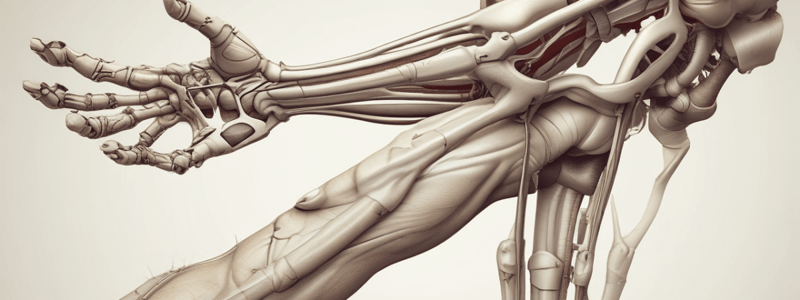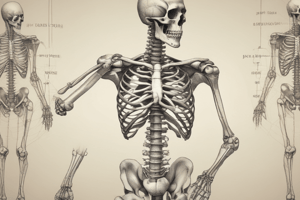Podcast
Questions and Answers
Which bone is the largest and weight-bearing in the leg?
Which bone is the largest and weight-bearing in the leg?
- Tibia (correct)
- Metatarsal
- Fibula
- Phalanges
Which joint does the tibia articulate with?
Which joint does the tibia articulate with?
- Hip joint
- Ankle joint
- Shoulder joint
- Knee joint (correct)
What is the primary function of the foot and ankle during movement?
What is the primary function of the foot and ankle during movement?
- To act as a lever to thrust the body forward (correct)
- To provide stability during movement
- To flex the body during walking
- To absorb shock during running
What type of forces does the tibia resist?
What type of forces does the tibia resist?
What is the orientation of the foot in relation to the leg?
What is the orientation of the foot in relation to the leg?
What type of joint connects the tibia and fibula?
What type of joint connects the tibia and fibula?
What is the effect of shortening of the limb on the medial rotators?
What is the effect of shortening of the limb on the medial rotators?
What type of hip fractures have a better healing outcome?
What type of hip fractures have a better healing outcome?
What is the primary reason why females are more prone to hip fractures than males?
What is the primary reason why females are more prone to hip fractures than males?
What is the consequence of interrupting the blood supply to the head of the femur?
What is the consequence of interrupting the blood supply to the head of the femur?
What is the primary cause of osteoporosis in post-menopausal women?
What is the primary cause of osteoporosis in post-menopausal women?
What is the most common type of patient who experiences a hip fracture?
What is the most common type of patient who experiences a hip fracture?
What is the effect of a fall on the elderly?
What is the effect of a fall on the elderly?
What is the significance of the angle of inclination in hip fracture?
What is the significance of the angle of inclination in hip fracture?
Which bursa is in continuity with the hip joint cavity?
Which bursa is in continuity with the hip joint cavity?
What is the primary reason for the femur's shaft being pushed laterally away from the joint proximally?
What is the primary reason for the femur's shaft being pushed laterally away from the joint proximally?
What is the primary cause of iliopsoas bursitis?
What is the primary cause of iliopsoas bursitis?
What is the angle of inclination of the femur's neck in males?
What is the angle of inclination of the femur's neck in males?
What is the term for an angle of inclination above 130 degrees?
What is the term for an angle of inclination above 130 degrees?
Which bursa is situated between the hamstring tendons and the ischial tuberosity?
Which bursa is situated between the hamstring tendons and the ischial tuberosity?
What is the primary symptom of trochanteric bursitis?
What is the primary symptom of trochanteric bursitis?
What is the anatomical axis of the femur?
What is the anatomical axis of the femur?
What can trigger the development of bursitis?
What can trigger the development of bursitis?
What happens to the angle of inclination in the elderly?
What happens to the angle of inclination in the elderly?
What is the location of the iliopsoas bursa?
What is the location of the iliopsoas bursa?
What is the mechanical axis of the femur?
What is the mechanical axis of the femur?
What is the significance of a right angle (90 degrees) in the angle of inclination?
What is the significance of a right angle (90 degrees) in the angle of inclination?
Which bursa is situated between the greater trochanter and the gluteus maximus muscle?
Which bursa is situated between the greater trochanter and the gluteus maximus muscle?
What is the primary cause of ischial bursitis?
What is the primary cause of ischial bursitis?
What is the typical angle of inclination in newborns?
What is the typical angle of inclination in newborns?
What is the age range for which the condition mentioned in the first paragraph commonly occurs?
What is the age range for which the condition mentioned in the first paragraph commonly occurs?
What is the primary goal of treatment for the condition described in the first paragraph?
What is the primary goal of treatment for the condition described in the first paragraph?
What is the approximate number of hip replacement operations performed every year?
What is the approximate number of hip replacement operations performed every year?
What is the ratio of females to males undergoing hip replacement operations?
What is the ratio of females to males undergoing hip replacement operations?
What is a risk factor for developing osteoarthritis of the hip in young individuals?
What is a risk factor for developing osteoarthritis of the hip in young individuals?
What is the result of the destruction of articular cartilage in osteoarthritis?
What is the result of the destruction of articular cartilage in osteoarthritis?
What are the bony spurs that develop around the margins of the joint in osteoarthritis?
What are the bony spurs that develop around the margins of the joint in osteoarthritis?
What is the condition that causes pain around the hip, in addition to osteoarthritis?
What is the condition that causes pain around the hip, in addition to osteoarthritis?
Flashcards are hidden until you start studying
Study Notes
Bones of the Lower Limb
- The distal part of the limb consists of the tibia and fibula, with the tibia being the largest and weight-bearing bone.
- The tibia articulates with the knee joint, while the fibula is excluded from the knee joint but participates in the ankle joint.
- The leg bones are held together by joints at both ends and an interosseous membrane.
- The foot is held at right angles to the leg and contains the tarsal bones, metatarsal bones, and phalanges.
- In standing, weight is transmitted from the ankle joint posteriorly via the tarsal bones to the heads of the metatarsals.
Femur
- The shaft of the femur is pushed laterally away from the joint, and its long neck keeps the shaft well away from the joint.
- The angle of the line drawn down through the shaft is the anatomical axis of the femur, which differs between sexes and ages.
- The neck is angled upwards between 120-130 degrees relative to the shaft, termed the angle of inclination.
- The angle of inclination varies with age, with new-borns having an angle of approximately 160 degrees, decreasing to 125 degrees in adulthood.
Hip Fracture
- Hip fractures can occur at the intertrochanteric, subtrochanteric, transcervical, or subcapital regions, with different outcomes.
- Fractures in the elderly are more likely to have been caused by the fall, and females are more prone to hip fractures due to a reduced angle of inclination and osteoporosis.
Blood Supply of the Hip Joint
- Avascular necrosis occurs when the blood supply to the head of the femur is interrupted, leading to the death of the head within 6 hours.
- Hip dislocation is a clinical emergency, and treatment involves relieving stress on the femoral head by applying traction to the joint.
Osteoarthritis of the Hip
- Osteoarthritis of the hip is a common condition worldwide, with approximately 800,000 hip replacement operations performed every year.
- It is more common in patients over 60, with females outnumbering males by a ratio of 3:1.
- Osteoarthritis involves destruction of the articular cartilage, with resultant loss of the joint-space, and may lead to bony spurs around the joint margins.
Hip Bursitis
- Hip bursitis occurs when the bursae around the hip joint become inflamed, causing pain.
- There are three main bursae: trochanteric bursa, ischial bursa, and iliopsoas bursa.
- Each bursa can become inflamed due to repetitive movements, athletic activity, or inflammatory conditions.
Studying That Suits You
Use AI to generate personalized quizzes and flashcards to suit your learning preferences.



